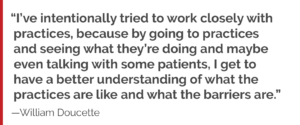
29
November

Alumnus William Doucette’s practice-focused research aims to amplify pharmacists’ impact
By Katie Gerhards
Some pharmacists conduct their research in the lab, and others in clinical settings. Yet others, like Bill Doucette (BS ’83, MS ’88, PhD ’93) seek the answers to their research questions within community pharmacies themselves.
Doucette, a triple-threat pharmacy Badger holding degrees in both pharmacy and social and administrative science from the University of Wisconsin–Madison School of Pharmacy, devoted his career to pursue one overarching question: How can pharmacists have the greatest positive impact on patient health?
Pharmacists, despite their years of education and training, the scope of their capabilities isn’t fully utilized, he says. And he’s working to change that.
“I look at it as an opportunity for more research to better understand what can potentially be done,” says Doucette, who is now a professor of pharmacy at the University of Iowa. He does some policy-related research, but spends most of his efforts in community pharmacies, speaking with practitioners about their obstacles.
“Most of my work is geared toward enabling the pharmacies themselves be more agile,” he says. “Pharmacists will call me or let me know about opportunities they see, and then we can discuss methods to find out what practices can do, what can they change in their strategy or operations, how they can implement a new type of service, or what needs to change to be successful.”
This mindset is part of what sets Doucette apart as a researcher, says Professor Dave Mott (BS ’88, MS ’92, PhD ’95) chair of the School of Pharmacy’s Social and Administrative Sciences Division.
“Even when we were in graduate school together here at the School of Pharmacy, he has always been very focused on community pharmacists and how they can add value to the medication therapy experience,” Mott says. “He’s super successful in this area and I think that’s largely been enabled by his training to approach these issues, break apart the problem, and figure out from a development standpoint what has to happen for the pharmacy to implement a service in the right way.”
Doucette isn’t a practicing pharmacist, but his close relationships with practitioners keep him informed about issues they’re currently facing, both challenges and opportunities, and Doucette—with his training social and administrative pharmacy—digs into the structures and frameworks of policy and practice that could impact them.
With more than 170 publications under his belt, he is more than up to the task.
Finding a passion for practice-based research
As the son of a nurse, Doucette had a longstanding interest in health care. He knew the local pharmacists in his northern Wisconsin hometown and enjoyed talking with them about their careers. He liked what he heard, and in college he applied to the UW–Madison School of Pharmacy.

During pharmacy school, where he met his wife, Jane (BS ’83), he had been drawn to management-related courses and topics. After practicing for a few years following graduation, he and Jane, who is now a hospital pharmacist, began to consider buying a pharmacy and running it themselves, so he returned to the School to pursue his master’s degree through the Division of Social and Administrative Sciences and learn more about pharmacy administration and management.
Doucette studied under Professor Joseph Wiederholt, a prolific researcher and namesake of the American Pharmacists Association’s coveted Wiederholt Prize, which recognizes the best paper published in the Journal of the American Pharmacists Association each year and was re-named in his honor after his passing in 2002.
“Under Professor Wiederholt, I got really interested in doing research,” says Doucette. “Instead of just leaving with a master’s degree, I stayed and got a PhD and really learned how to do in-depth research surrounding pharmacy practice.”
During his time at the School of Pharmacy, Doucette also took an array of marketing and business courses through the Wisconsin School of Business—an option that’s now available to students in the PharmD program—that became useful in studying pharmacy services and how workflow affects service delivery. “All of the coursework from UW–Madison has really given me a well-equipped toolbox to draw upon.”
‘Going to Neptune’ to build collaborative practices
Through Wiederholt’s tutelage, Doucette picked up a couple of habits that he maintains to this day. One of them pushes brainstorming further than just “outside of the box.”
“He had a phrase, ‘going to Neptune,’ where we’d start brainstorming and following new ideas and building off of them,” he says. “That’s been something that I’ve tried to keep my whole career because new ideas are really where the opportunities are.”
This tactic stuck with Doucette through his time as a faculty member with the University of Utah and now at the University of Iowa. “It’s been a really fruitful pathway,” he says.
One area of his research that’s benefited from that approach is fostering collaboration and communication between pharmacies and clinics for a team care approach.
In an ongoing Centers for Disease Control-funded project with the Iowa Department of Public Health, Doucette is studying how different levels of pharmacist-physician cooperation can help patients control high blood pressure. In higher-risk areas of Iowa, the project also addresses high cholesterol and other conditions that influence cardiovascular health.
![“[Dr. Wiederholt] had a phrase, ‘going to Neptune,’ where we’d start brainstorming and following new ideas and building off of them. That’s been something that I’ve tried to keep my whole career.”](/wp-content/uploads/Pull-Quote_Doucette-Wiederholt-300x147.png)
Previously, he conducted similar studies to examine pharmacist-driven interventions to help manage patients with diabetes. Implementing those interventions through the framework of a collaborative working relationship model he developed—which synthesizes work experience and collaboration conceptual models to work through how pharmacists can advance their working relationships with physicians—he found that sharing feedback with physicians, reviewing the patients’ medications, and assessing patients’ beliefs about health and medication are some of the most effective ways pharmacists can boost patient outcomes.
“I’ve been interested in how pharmacists can provide services and support to patients, and perhaps act as an intermediary for managing the medications, working with the prescribers and the patients to better understand what they’re really taking at home,” Doucette says.
Maintaining regimens becomes especially problematic when patients are discharged from hospitals, because often their medications have changed throughout their stay, and they might not be fully functional when they’re receiving new or changed medication information. And if patients need to stay in a rehabilitation facility before returning home, there’s yet more opportunity for messages to get crossed.
“This is one of the services and roles that pharmacists can fulfill, especially in community pharmacies, because they’re well-positioned and trained to review medications with patients after discharge,” he says.
Creating a tool for medication adherence
In addition to helping patients understand how much of what drug they’re supposed to take, Doucette also wants pharmacists to be intimately involved in helping patients understand the medications themselves—what side effects to look for and how they’re improving patient health.
“Some medication effects are the desired effects, making blood pressure or blood sugar go down in the case of insulin or other diabetes medications,” he says. “But those types of medications often have lower adherence because they aren’t resolving obvious symptoms, so there’s not a clear reinforcement.”

There is a range of potential reasons why patients don’t adhere strictly to a prescription medication regimen: they might get confused, forget, have difficulty affording them or accessing them, or make a conscious decision to not take them because they are unsure they will help. It’s also not uncommon for patients to be seeing more than one physician or specialist at a time, and sometimes those physicians aren’t fully synced up on all of the patients’ medications.
Pharmacists can monitor patient adherence at the time of a refill by seeing how many doses were dispensed last time, and if their newest refill fits the expected timeline. Another method of overcoming nonadherence Doucette has tested is medication synchronization, during which all prescriptions are coordinated to be dispensed at the same time.
“It provides a better opportunity for the pharmacist to make an assessment of their medications because if patients don’t need something they should, then the pharmacist can start a conversation about why,” he says. “Those conversations hopefully allow the pharmacist to better understand what’s going on and see if there is an unsafe or inappropriate change in how they’re taking their medication.”
Pharmacists can then work with a patient and the prescriber to get things changed if needed, overcoming prescriber fragmentation and reviewing medications more holistically.
Doucette also helped create a tool that’s in use by pharmacists across the country to improve adherence by uncovering and understanding the hurdles: the Drug Adherence Workup, or DRAW tool, which is a concise checklist to guide pharmacists’ conversations with patients about their experience and with their medication therapy. The DRAW tool also includes some points of reflection for the pharmacist and recommended follow-up actions as well.
“There’s a lot of safety work that’s done when drugs are developed, but we need ongoing research for after the drugs are on the market and people are taking them at home under their own supervision—they’ve been told the directions and hopefully they’ve been counseled on the risks and benefits, but sometimes people get confused.”
Patients are too often left on their own, Doucette says. And pharmacists could and should be the resource they’re lacking.
The next frontier for pharmacists
Although Doucette has been making strides in helping community pharmacists enhance their range of services, there is one area that’s top-of-mind but harder to tackle: getting provider status.
“I would say the practice environment in general doesn’t fully utilize pharmacist training and abilities,” he says. “It’s not easy for pharmacists to get paid for providing non-dispensing services,” such as medication management or point-of-care testing.
But progress is being made. Doucette worked with one payer on a pilot study, testing continuous medication monitoring in which the safety and effectiveness of medications are evaluated by pharmacists at every time they’re dispensed. The results, evaluated on medication adherence and total cost of care, were so positive that the test was rolled out in a broader program for the whole state, now evaluating around 75 pharmacies. These are the types of studies that Doucette finds most encouraging. “If even one payer has success, and then other payers and peers see that and they start to copy that process.”
Another brick in the road to pharmacists gaining greater recognition as health care providers is access to patient health records. Currently, pharmacists in most community practices are connected to pharmacy records, but not hospital or clinic records—and it’s not easy for them to get that connection.
“If those connections are there, pharmacists can better utilize their training and their skills to help the patient within the full context of their health, and can likewise help the clinic and hospital get scored better on their quality indicators,” he says. “They’re all of our mutual patients.”
“I view myself as a grassroots worker,” Doucette says. “I’ve intentionally tried to work closely with practices, because by going to practices and seeing what they’re doing and maybe even talking with some patients, I get to have a better understanding of what the practices are like and what the barriers are.”
“It’s a challenging environment, but that’s why it’s important to be positive and upbeat,” he says. “That’s another lesson I still carry from Dr. Wiederholt: Be upbeat and get excited about new opportunities and new ideas, and then take them to Neptune.”
Learn more about the School of Pharmacy’s graduate programs in Social and Administrative Sciences in Pharmacy.


![“[Doucette] has always been very focused on community pharmacists and how they can add value to the medication therapy experience.”](/wp-content/uploads/Pull-Quote_Dave-Mott-Doucette-1024x400.png)



